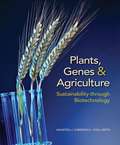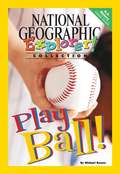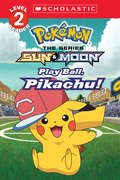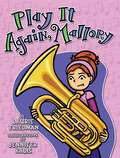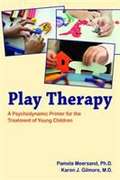- Table View
- List View
Plants and Animals in Different Seasons
by Tara Funk Kira FreedLearn how plants and animals change in different seasons.
Plants, Genes, and Agriculture: Plants, Genes, and Agriculture
by Paul Gepts Maarten Chrispeels<p>What needs to happen if we are going to feed almost 10 billion people by the year 2050 in a sustainable way? Written for first- and second-year university students, this interdisciplinary textbook addresses this challenging question, presenting biological, economic, and sociocultural issues at an introductory level. <p>Presenting and integrating information from many disciplines, this book invites readers to consider the complexity of feeding humanity and increasing food production sustainably. <p>Topics covered include: <p> <li>the development, physiology, and nutrition of plants <li>human nutrition and food safety <li>photosynthesis and energy transformations <li>genetics, molecular biology, and genomics, including the techniques of genetic transformation (gene silencing, gene editing with CRISPR) used in modern crop breeding <li>crop domestication and plant breeding <li>soil ecosystems <li>the biotic (animal pests, diseases, and weeds) and abiotic (drought, flooding, temperature extremes, and soil degradation) stresses that limit crop production <li>technological advances and how new innovations (equipment, chemical products, and improved plant varieties) reach farmers and eventually affect what we eat; also discusses legal aspects (e.g., patents) relevant to agricultural innovations <li>plants as sources of pharmaceuticals and specialty chemicals</li> <p> <p>Although publicized in the controversies surrounding "genetically modified organisms" (GMOs), the applications of modern biotechnology to agriculture extend far beyond GMOs, and include crop improvements that rely on knowledge of the plant's genomes and its analysis by bioinformatics. This unifying theme of the text is stressed in coverage of a number of issues that appear throughout the chapters, including: <p> <li>how crop plant breeders look for specific traits to solve practical problems <li>genetic engineering of crops as a useful way to supplement conventional plant breeding <li>the nature of agribusiness in industrialized countries <li>the vital contributions of developing countries and their smallhold farmers, and the unique challenges facing them </li> <p> <p>Challenging and controversial topics such as the safety of pesticides and GMOs, the increasing demand for animal products and the stresses this puts on agricultural output, organic farming and foods, and patenting new crop varieties are dealt with in a balanced way, inviting teachers and students to consider all the implications of these serious questions.</p>
Plastic Eaters: Wax Worms on the Job (Fountas & Pinnell Classroom, Guided Reading Grade 6)
by Catherine JohnWorms Hold the Key Plastic is piling up everywhere, clogging landfills and oceans. Even as people around the globe recycle and reuse plastic, the problem persists. But scientists may have discovered a solution: WORMS! Yes, wax worms may hold the key to solving our plastic problem. Read on to discover why scientists are so excited about these white wiggly worms. NIMAC-sourced textbook
Plate Motion Engineering Internship: : Tsunami Warning Systems (Engineering Notebook)
by The Lawrence Hall of ScienceNIMAC-sourced textbook
Plate Motion Engineering Internship: Tsunami Warning Systems, Article Compilation
by The Lawrence Hall of ScienceNIMAC-sourced textbook
Plate Motion Engineering Internship: Tsunami Warning Systems, Engineering Notebook, with Article Compilation
by The Lawrence Hall of ScienceNIMAC-sourced textbook
Plate Motion: Mystery of the Mesosaurus Fossils (Article Compilation)
by The Lawrence Hall of ScienceNIMAC-sourced textbook
Plate Motion: Mystery of the Mesosaurus Fossils (Investigation Notebook)
by The Lawrence Hall of ScienceNIMAC-sourced textbook
Plate Motion: Mystery of the Mesosaurus Fossils, Investigation Notebook with Article Compilation
by The Lawrence Hall of ScienceNIMAC-sourced textbook
Plato Was Wrong! Footnotes on Doing Philosophy with Young People
by David A. ShapiroThis book is a compendium of lesson plans for classroom exercises designed to foster philosophical inquiry with young people. It introduces the reader to a wide range of activities for exploring philosophical questions and problems with children from pre-school age through high-school. There are lessons for a full-range of topics in philosophy, including metaphysics, epistemology, ethics, and aesthetics, and each is intended to help foster a supportive and caring classroom community of inquiry. All of the activities have been used on numerous occasions and include reflections on what teachers who employ the lesson might expect when doing so. Using this book, teachers, parents, and others can successfully being fostering philosophical inquiry with young people of all ages.
Platos sanos una vida saludable (¡Arriba la Lectura! Read Aloud Module 4 #1)
by Valerie BoddenNIMAC-sourced textbook
Play Ball, Pikachu! (Pokémon: Scholastic Reader, Level 2)
by Sonia SanderKids can practice their reading skills with Pokémon in this fun Level 2 Reader!Join Ash and Pikachu on an adventure in Alola!The kids from Pokémon School can't wait to play Pokémon Base with the famous sports star Oluolu and his partner, Snorlax. But when Team Rocket tries to get on the game, the play turns foul! Can Ash and his Pokémon help Snorlax save the game... and the day?This Level 2 Reader is based on the hit animated series, with full-color illustrations throughout!
Play It Again, Mallory (Mallory #20)
by Laurie FriedmanMallory is excited about the six-week arts electives program at Fern Falls Elementary—until she gets stuck in her last-choice class, band. To make matters worse, she is assigned to the tuba, and when she plays, it sounds more like passing gas than music. She dreads the showcase at the end of the program. But with some good guidance from her mom and her band teacher, Mallory learns the meaning of "practice makes perfect" and that, in fact, making music can be lots of fun!
Play It Safe (Reach Into Phonics Ser.)
by Deborah J. Short Lorna Shore Sterling SpearNIMAC-sourced textbook
Play Therapy: A Psychodynamic Primer for the Treatment of Young Children, First Edition
by M. D. Pamela Meersand Karen J. GilmoreA Psychodynamic Primer for the Treatment of Young Children provides a contemporary, comprehensive exploration of the theory and technique of psychoanalytically oriented play therapy, addressing both the dearth of writings on these topics and the frequent lack of in-depth education on the basic principles and practice of psychodynamic play therapy offered by contemporary training programs for child clinicians.

